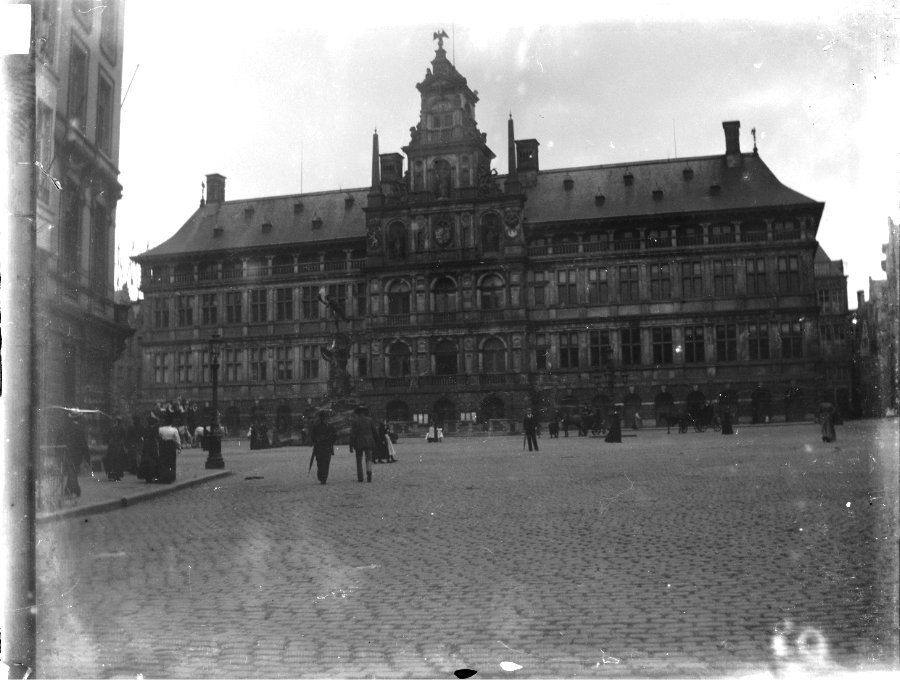10. Hotel de Ville, Antwerp - 9 Sept 1900 | Glass Plates
Known as the Hotel de Ville d'Anvers in French, the Stadhuis van Antwerpen in Dutch, and Antwerp City Hall in English, this elegant Renaissance structure is the jewel of the city’s Great Market Square. Originally built between 1561 and 1564, at a time when Antwerp was one of the busiest trade ports in Europe, its intricate detailing, Flemish and Italian inspired designs, and size displayed the wealth of the city to all passing through.
When it was raised, the Hotel de Ville stood as a symbol of the city’s wealth and prosperity above all other cities in the Low Countries. Yet this architectural statement would soon be stifled in an era of social and religious turbulence.
Only eleven years after its completion, the building was burnt to a shell during the so-called Spanish Fury; a rampage by unpaid Spanish troops and mercenaries stationed in the city. The sacking of Antwerp led to the city’s decline as the major trading hub, being replaced by nearby Amsterdam. This senseless violence by Spanish troops, as well as tensions between the increasingly Protestant Netherlands and the staunchly Catholic Spain, united many with the rebels as part of the near century long Dutch Revolt (1566-1648) against Spanish rule, which eventually led to the creation of the United Provinces of the Netherlands.
Following its burning during the Spanish Fury, the Hotel de Ville was restored around 1579 using much of the original design.
The above photograph, taken on the 9th of September 1900, shows sparse groups of people milling about the city square. On the right on the frame, in the shadow of the building, is a horse and carriage waiting for passengers. It seems a quiet Sunday scene in the city.
In front of the Hotel de Ville is the iconic Brabo Fountain, depicting the graphic myth of the city’s origins…
Brabo the Giant-Slayer: His Rise, Fall, and Return
The work of Belgian sculptor Jef Lambeaux, and inaugurated in 1887, the fountain depicts a naked man throwing a severed hand that is notably much larger than his own, the clear water of the fountain spurts from the wrist to represent the spray of blood from the newly severed limb.
The national myth on display with this sculpture is that of Silvius Brabo’s defeat of the giant Druon Antigoon. Legend tells that the greedy giant would demand payment from any ship’s captain who passed through his stretch of the river Scheldt (which runs through the modern city). As punishment for any who refused to pay, or out of spite with those who simply couldn’t, the giant would cut off one of their hands and throw it into the river.
Hearing of the giant’s cruelty, and likely wishing to make a name for himself, Silvius Brabo, a frontier Roman Legionary, sailed down the river to meet with Antigoon. When the giant appeared and demanded payment, Brabo refused and challenged him to a duel.
It is not recorded how gruelling the fight was, how many blows each struck, or how victory was achieved, but it was Brabo who triumphed. To celebrate his victory, and to deliver a fitting punishment to the giant, Brabo cut off Antigoon’s enormous hand and threw it into the river.
This somewhat apocryphal story is used as a way of explaining the etymology of the city’s Dutch name: Antwerpen. This, according to the theory, is a shortened form of Handwerpen: meaning “hand-throwing.”
It is clear by the fountain’s central position in the city that this story is a vital part of Antwerp’s mythological origins. What is less known is that the fountain is actually the second statue of Brabo to appear as a focal point for the Hotel de Ville.
Originally, when it was first built, the front façade of the Hotel de Ville included a statue of Brabo in the topmost alcove, so that the giant-slayer could look out on the city. This statue was pulled down following the Fall of Antwerp to the Spanish in 1585, likely because it was such an inspiring myth for the city to rally around. Instead, the victorious Alessandro Farnese returned control of the city to the Spanish Empire and replaced this secular giant-slaying symbol with a distinctly Catholic statue of the Virgin Mary (as seen in the alcove beneath the eagle in the photo).
Brabo’s return to a central position in the city following Belgium’s independence shows the symbolic power of such origin myths within the landscape and the influence of them on the perception of nationhood.
Brabo continues to stand triumphant.
Untangling the Jumbled List of Glass Plates
As mentioned in the previous blog post, this is glass plate number 10 on the list, but by date it is the earliest. Matters get further jumbled as we move forward as the next two photos appear to be listed as places in Antwerp, when they are in fact in Brussels. A peculiar mistake, but understandable considering the photographer was merely working from memory when organising them over a century ago.
Thank you for those who have joined me thus far, and I hope you will consider joining me next time when I rediscover the locations of the mislabelled glass plates.
References
Arnade, Peter, Beggars, Iconoclasts, and Civic Patriots: The Political Culture of the Dutch Revolt (Ithaca: Cornell University Press, 2018), p. 326
‘City Hall’, Visit Antwerpen Website <https://www.visitantwerpen.be/en/sightseeing/architecture-monuments/town-hall>
1900 Glass Plates: This project explores a series of glass plates from the year 1900 with the eventual goal of travelling the same route as the photographer. It will be a varied journey that will stretch from simple blog posts examining each photo to videos and more. This project is in collaboration with photographer Aleksandar Nenad Zecevic, who’ll be restoring the photographs to bring out details dimmed by time. More to follow.







